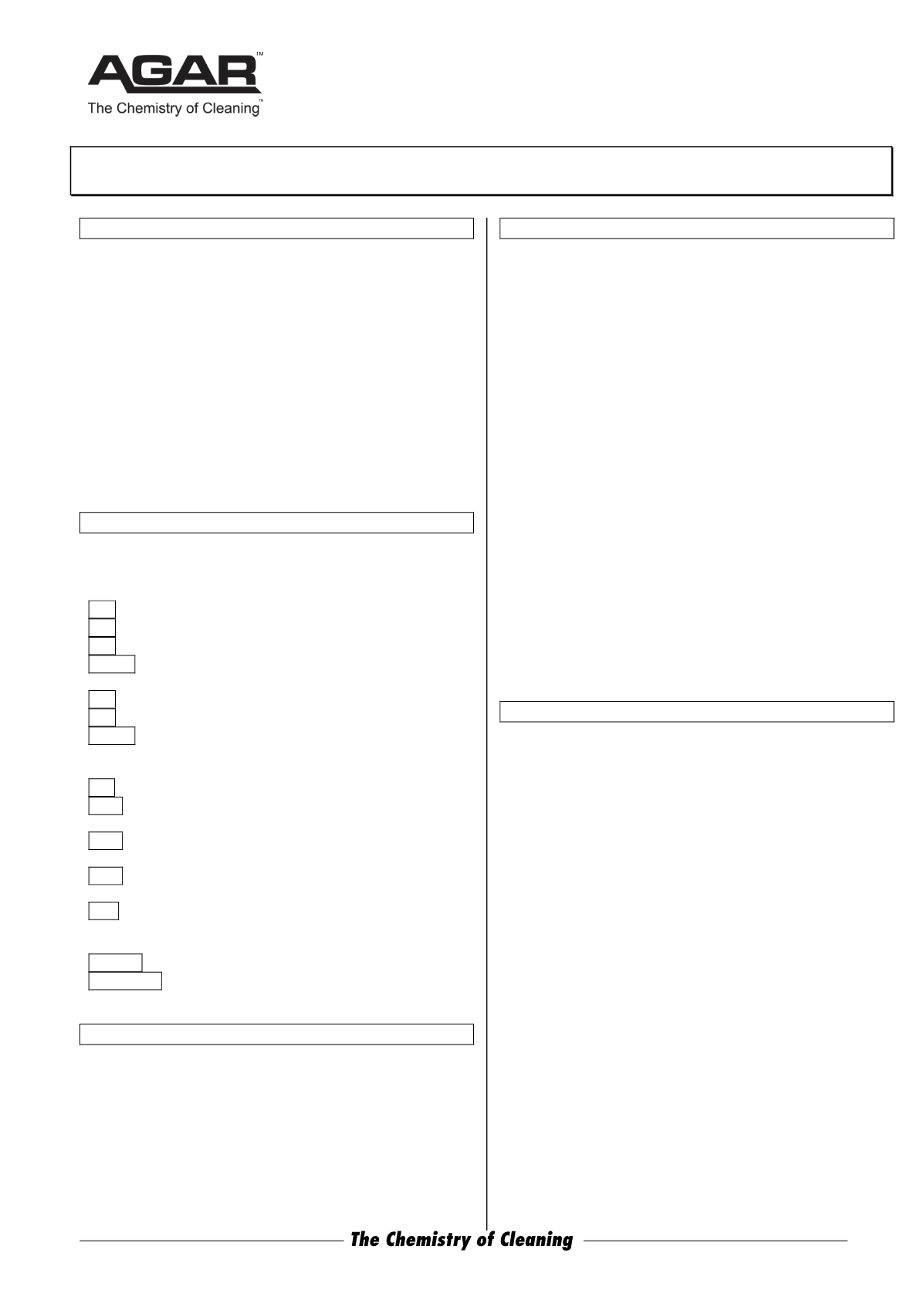

ABN 80 004 726 890 | MADE IN AUSTRALIA
VIC 03 9480 3000
NSW 02 9743 6020
SA 08 8293 2020
QLD 07 3274 3438
WA 08 9249 4566
Safety Data Sheet
Issued: February 28, 2012
Page 1 of 3
TYRE SHINE
1 IDENTIFICATION OF THE MATERIAL AND SUPPLIER
Product Name:
TYRE SHINE
Proper Shipping Name: FLAMMABLE LIQUID, N.O.S. (contains
solvent naphtha petroleum).
Manufacturer's Product Code: TY20
Product Use: Protective oil for use on rubber tyres.
SUPPLIER DETAILS
Company: Agar Cleaning Systems Pty. Ltd.
Address: 12-14 Cope Street, Preston, Vic. 3072
Telephone: 03 9480 3000 Facsimile: 03 9480 5100
Web:
www.agar.com.auAgar SDS are available from this website.
Email:
sales@agar.com.auEmergency Telephone Number: 131 126
(Aust wide)
2 HAZARDS IDENTIFICATION
Hazardous according to criteria of Safe Work Australia.
Harmful Xn
R11 Highly flammable.
R65 Harmful: may cause lung damage if swallowed.
R62 Possible risk of impaired fertility.
R48/20 Harmful: danger of serious damage to health
by prolonged exposure through inhalation.
R67 Vapours may cause drowsiness and dizziness.
R38 Irritating to skin.
R51/53 Toxic to aquatic organisms, may cause long-
term adverse effects in the aquatic environment.
S9 Keep container in a well-ventilated place.
S16 Keep away from sources of ignition – No
smoking.
S23 Do not breathe vapour. Use adequate explosion-
proof ventilation to control airborne concentrations.
S61 Avoid release to the environment. Refer to
special instructions/ Safety Data Sheet.
S62 If swallowed, do not induce vomiting: seek
medical advice immediately and show this container or
label.
S24/25 Avoid contact with skin and eyes.
S36/37/39 Wear suitable protective clothing, gloves
and eye/face protection.
3 COMPOSITION / INFORMATION ON INGREDIENTS
Ingredients:
Chemical Entity: CAS No.: Proportion:
Solvent naphtha (petroleum),
light aliphatic 64742-89-8 > 60%
containing the hazardous ingredients:
n-hexane 110-54-3
10 - < 30%
toluene
108-88-3 < 5%
and:
silicone oil non-haz
10 - < 30%
other ingredients determined not to be hazardous to 100%
4 FIRST AID MEASURES
Poisons Information Centre: Phone 131 126
Swallowed: If poisoning occurs, contact a doctor or Poisons
Information Centre. If swallowed, do NOT induce vomiting.
Never give anything by mouth to a drowsy or unconscious
person. If vomiting occurs spontaneously, or this appears
imminent, hold patient’s head down lower than their hips to
help prevent possible aspiration of vomitus. If vomiting occurs,
lean the patient forward or place them on their left-side with
head down, if possible, to maintain open airway. Observe
patient carefully. Avoid giving milk, oils or alcohol.
Eye: Immediately hold the eyes open and wash continuously for
at least 15 minutes with fresh running water. Ensure irrigation
under eyelids by occasionally lifting the upper and lower lids.
Transport to hospital or doctor without delay. Removal of
contact lenses after an eye injury should only be undertaken
by skilled personnel.
Skin: Remove any contaminated clothing and flush area with
water and soap if available. Seek medical attention in the
event of irritation.
Inhaled: If any effects are observed, remove affected person
from contaminated area to fresh air. Lay the patient down,
keep warm and rested. If breathing is shallow or as stopped,
ensure clear airway and apply resuscitation, preferably with a
demand-valve resuscitator, bag-valve mask device or pocket
mask as trained. Perform CPR if necessary.
5 FIRE FIGHTING MEASURES
Fire/Explosion Hazard: Tyre Shine is highly flammable.
Fire Extinguishing media: Foam. Dry chemical powder. Carbon
dioxide.
Fire Fighting PPE: Wear full protective clothing and self-
contained breathing apparatus.
Special fire-fighting procedures: Alert Fire Brigade and tell them
location and nature of hazard. Use water spray to cool fire-
exposed surfaces and to protect personnel. Shut off “fuel” to
fire. Do not use water in a jet. Prevent by any means available
spillage from entering drains or water courses. If any large
container (including road and rail tankers) is involved in a fire,
consider evacuation by 500 metres in all directions.
Unusual fire hazards: Carbon monoxide may be evolved if
incomplete combustion occurs. Will float and be re-ignited on
surface water. Vapour is denser than air, remote ignition is
possible. Avoid admixture with oxidising agents such as
nitrates, chlorine bleaches, pool chlorine, etc. as ignition may
result.
Hazardous products of combustion: Thermal decomposition in
large fire may yield toxic fumes and carbon dioxide.
Please turn to Page 2


















